Imagine swinging your sword blindfolded. You’re battling someone but don’t know who or what. An SEO competitor analysis contributes a lot to identifying your rivals. If you struggle to rank higher, one reason is failing to see who your competition is. You’re blind!
When you know who you’re competing with, crafting your strategy is easier. Moreover, knowing your opponents means you can gauge your performance more accurately. Yes, your website performs great but what if we told you you’re outranked by at least 10 or 15 more?
If you want to overtake them, you must have an insight into their backlinks, ranking keywords, writing quality, and much more. This is impossible without an SEO competitor analysis that can be performed with the top SEO tools, such as Semrush or SE Ranking.
SEO Competitor Analysis Explained
Before diving into our strategies, let’s clarify this process and highlight the importance of SEO competitor analysis.
In short, it’s a process of researching your competitors and discovering their SEO tactics and stats. For example, this process can tell you more about your competitor’s:
- Best-ranking keywords
- Referring IPs (backlinks)
- Content quality
- Organic/paid traffic, etc.
Knowing these things instantly lets you develop the strategy to beat your rivals. For example, if the rival ranks for the keyword “SEO tools for beginners”, you can try and outrank the domain through more clever keyword implementation, on-page SEO, or anything else.
In the same fashion, you can capitalize on your rival’s backlink weaknesses. If the rival lacks a backlink from an authoritative site, you’ll hurry up and try to get one. Analyzing and locating your opponents’ weaknesses isn’t a one-minute job. There are ample steps to complete.
However, if you give it a bit of time and effort, it’ll pay off immensely; in the end, that matters the most.
How to Run an SEO Competitor Analysis
Now that we’ve explained what an SEO competitor analysis represents, let’s guide you through the process.
Discover Your Competition
To remove the blindfold, you need to know your organic competitors. Semrush and SE Ranking have amazing Organic Research tools for that. We prefer Semrush’s variant because it’s a lot easier to use and instantly discovers your true “foes.”
Find it under Competitive Research.
Try Semrush Risk-Free
Try SE Ranking Risk-Free
From there, click on Organic Research and provide your domain’s address. Press Search.
© Semrush
You’ll immediately see your website’s number of keywords, traffic, top keywords, keywords by intent, etc. However, we want to scroll down a bit and find the Main Organic Competitors part. You’ll see a few right away but if you click on “View All Competitors“, you’ll find all.
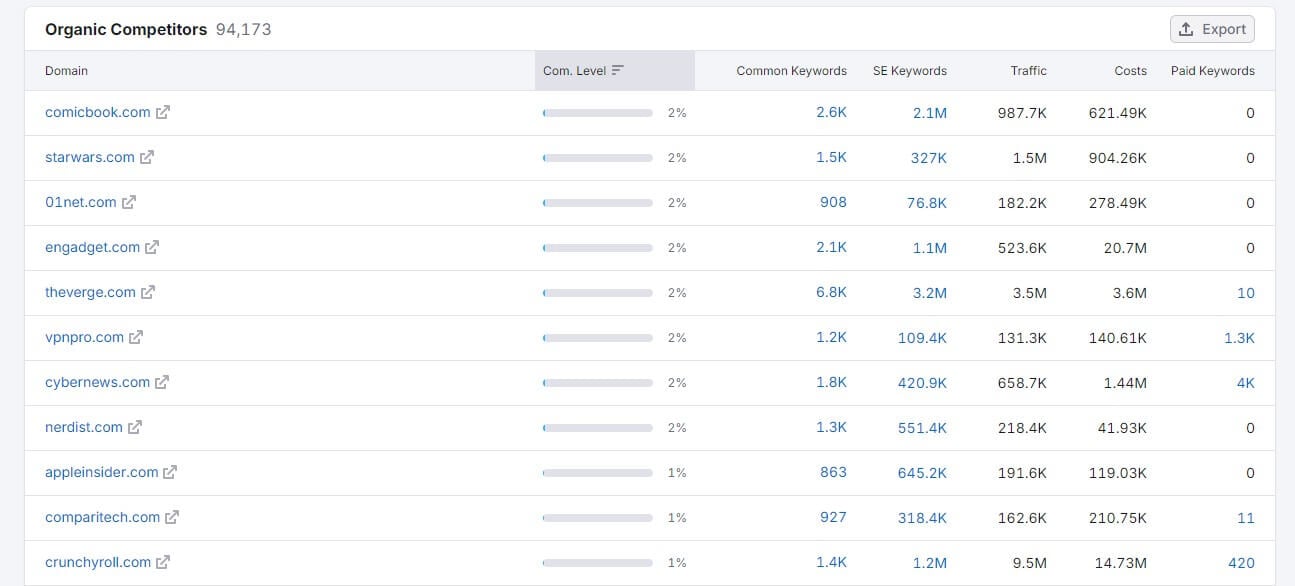 © Semrush
© Semrush
This comprehensive list displays numerous important factors. For instance, you’ll see the competition level; the higher it is, the higher the rivalry is between you and the domain in question. Common keywords and SE keywords are also there; a useful metric if you ask us.
This table lets you directly compare your domain to others and see what kind of force you’re up against. Don’t forget that you can also click on the domain you want to see its related info. You can, thus, detect its keywords, position changes, and authority; quite important.
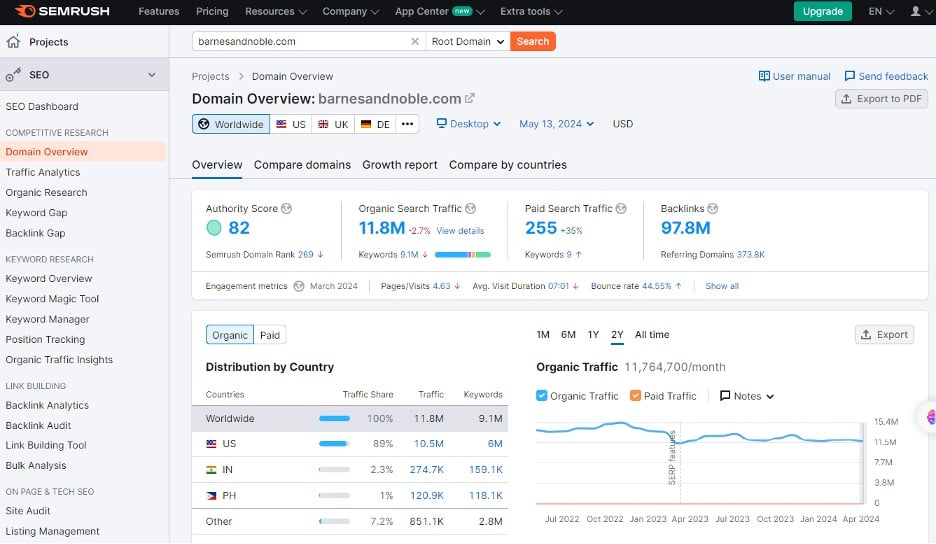 © Gizmodo.com
© Gizmodo.com
Knowing the authority of your competitor is another clear gauge. If its authority is higher than yours, you’ll need to work on it. A good keyword tool can help but bumping up the content quality and being more insightful is another strategy.
Find Your Competitors With Semrush
Analyze Your Competitor’s Keywords
We briefly touched on keywords, so let’s continue. How to perform a keyword-related SEO competitor analysis? There are a few important steps. In fact, this aspect is vital because proper keyword optimization is one of the largest contributors to your site’s performance.
Detecting Keyword Gaps
There’s going to be a gap between you and your competitor. The term “keyword gap” refers to the keywords your rival ranks for but you don’t. You won’t know what these keywords are unless you find them using a reliable SEO tool. Semrush is our favorite; it’s very intuitive.
Under Competitive Research, located the Keyword Gap tool. Remember the competitors you’ve identified in the previous step? Now, you can add up to 4 of them at a time but first, provide your domain that will be compared to these 4. Select the country as well.
Finally, decide if you want to compare organic, paid, or PLA keywords. After you’re done, click Compare and in seconds, you’ll see everything you need. Scroll down a bit and there will be a large table. The first column displays shared keywords.
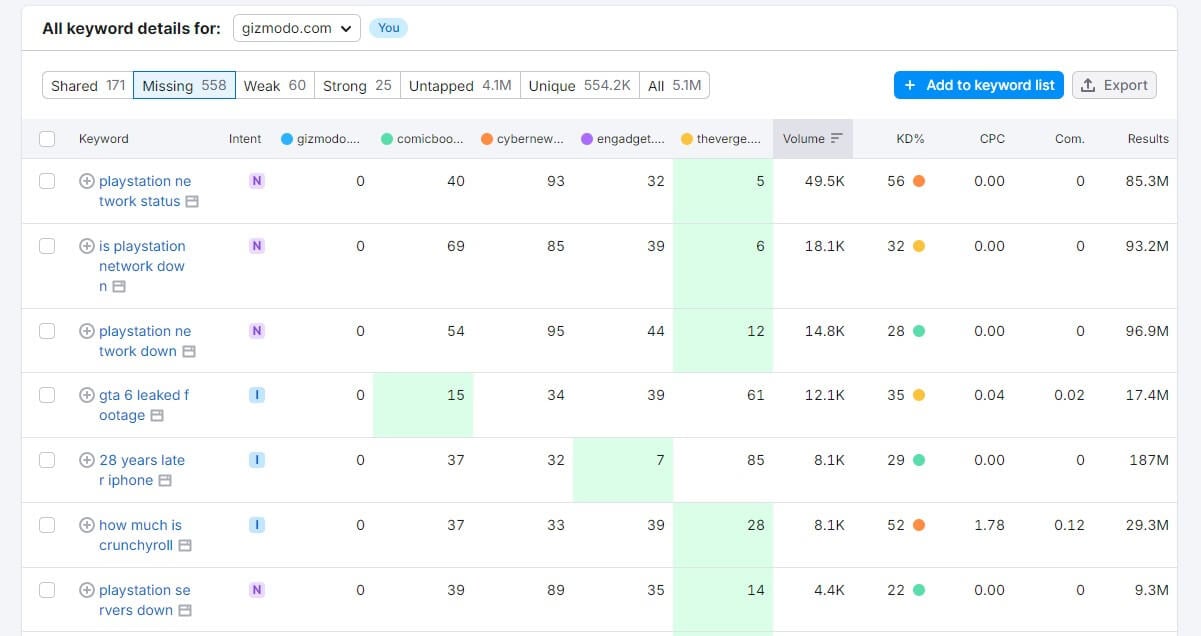 © Semrush
© Semrush
However, you want to click on Missing; that’s the gap you need to fill.
As you can see, a few of our competitors rank for the “GTA 6 Leaked Footage” keyword; our website doesn’t. This keyword isn’t relevant to our website, so we won’t bother with it. We intentionally say this because you don’t have to rank for every keyword in this case.
If the keyword is out of your niche, avoid it. A good way to discover more missing keywords is by choosing the Untapped option.
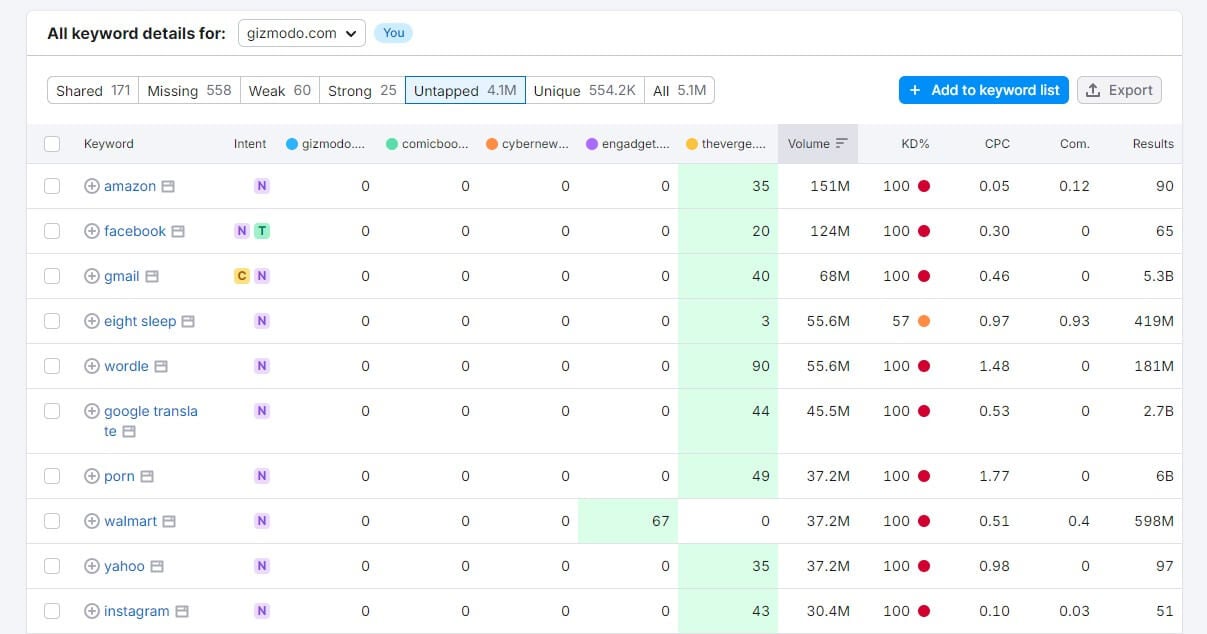 © Semrush
© Semrush
It displays the keywords at least one of your rival websites ranks for but you don’t. This is useful for targeting specific websites.
Finding New and Lost Keywords
Ranking for one keyword doesn’t mean you’ll forever enjoy this privilege. Keywords can be lost and you surely don’t want that; unless we’re talking about your rivals! There’s another case in which you can gain a new keyword ranking; the same can happen with your foes.
You’ll want to identify both scenarios and capitalize on them as soon as possible. We always use Semrush and its Organic Research for this purpose. It works wonderfully. Now, instead of typing your domain, analyze a specific competitor; we leave this to you.
When the results appear, select the Position Changes tab and look at the table below. You’ll see the filter column, where you’ll press Position Changes and then tick Lost and press Apply. Semrush will now display lost keywords, signifying the loss of ranking for them.
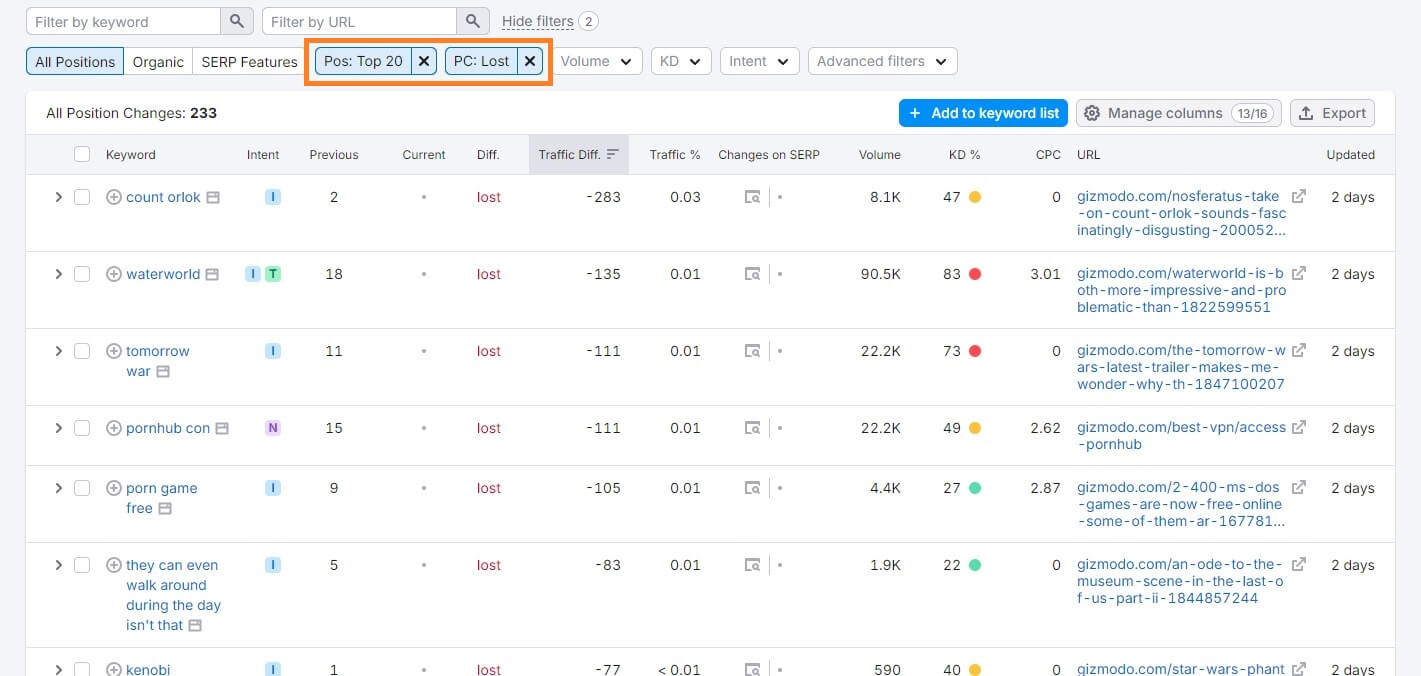 © Semrush
© Semrush
To narrow the search, click the Positions filter and select Top 20. Now that you know the lost keywords of your rival, you can press the pedal to the metal and try to rank for them or at least one of them. You can discover new keywords the same way.
Instead of Lost, select New and press Apply.
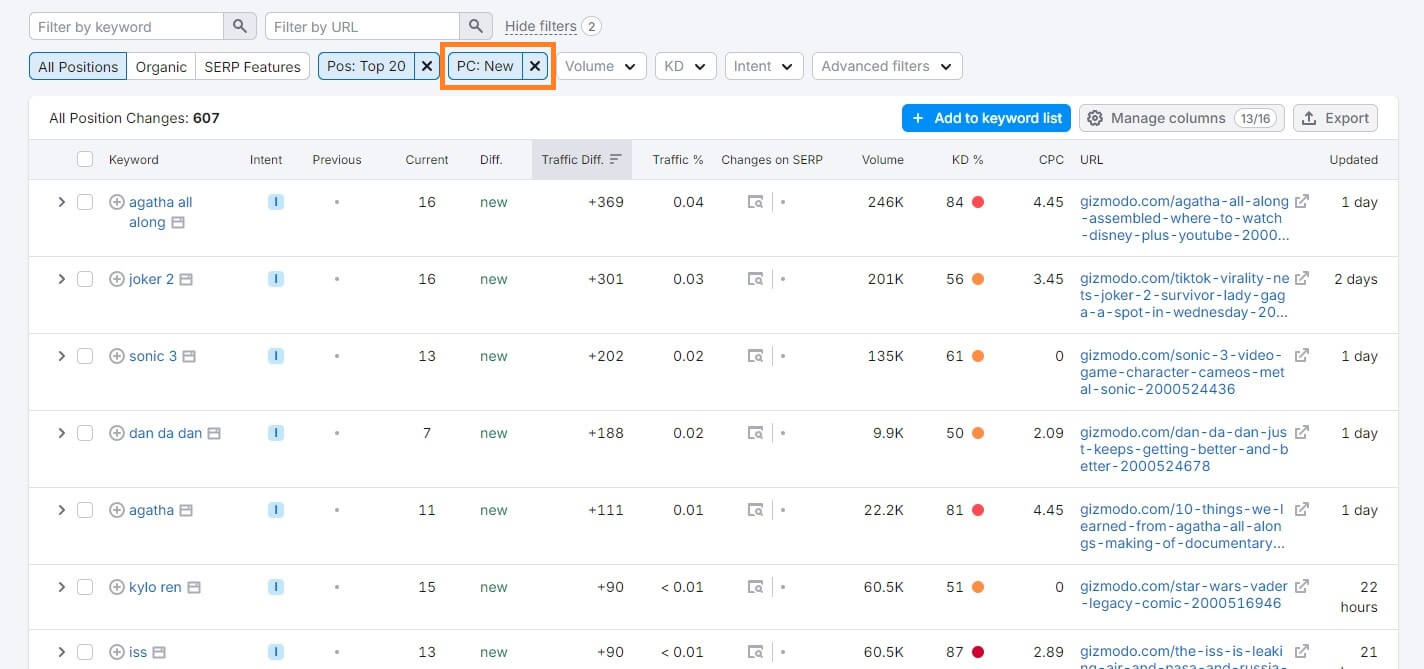 © Semrush
© Semrush
Why would you do that? For similar reasons. You can try a direct “battle” and aim for the same keyword(s). Or you can simply use this to track the trajectory of the rival website and replicate it if it fits your niche.
Improve Your KW Optimization With Semrush
Gain Insight Into the Backlink Profile
Keywords and backlinks are the kings of SEO. Have both SEO aspects impeccable and your Google rank will skyrocket in mere weeks or months. Backlinks are, however, more complex than keywords in terms of obtaining and maintaining their number and quality.
Simultaneously, performing an SEO competitive analysis and discovering your rivals’ backlinking strategies can help tremendously if you’re lost. Here are the best SEO competitor analysis practices to make your research more efficient.
Backlink Analysis
Performing a basic backlink analysis is always a good thing. You can pick SE Ranking and do that or go via the Backlink Analytics tool in Semrush. Either way, provide the domain address and you’ll find its authority score, referring domains, monthly visits, and toxicity score.
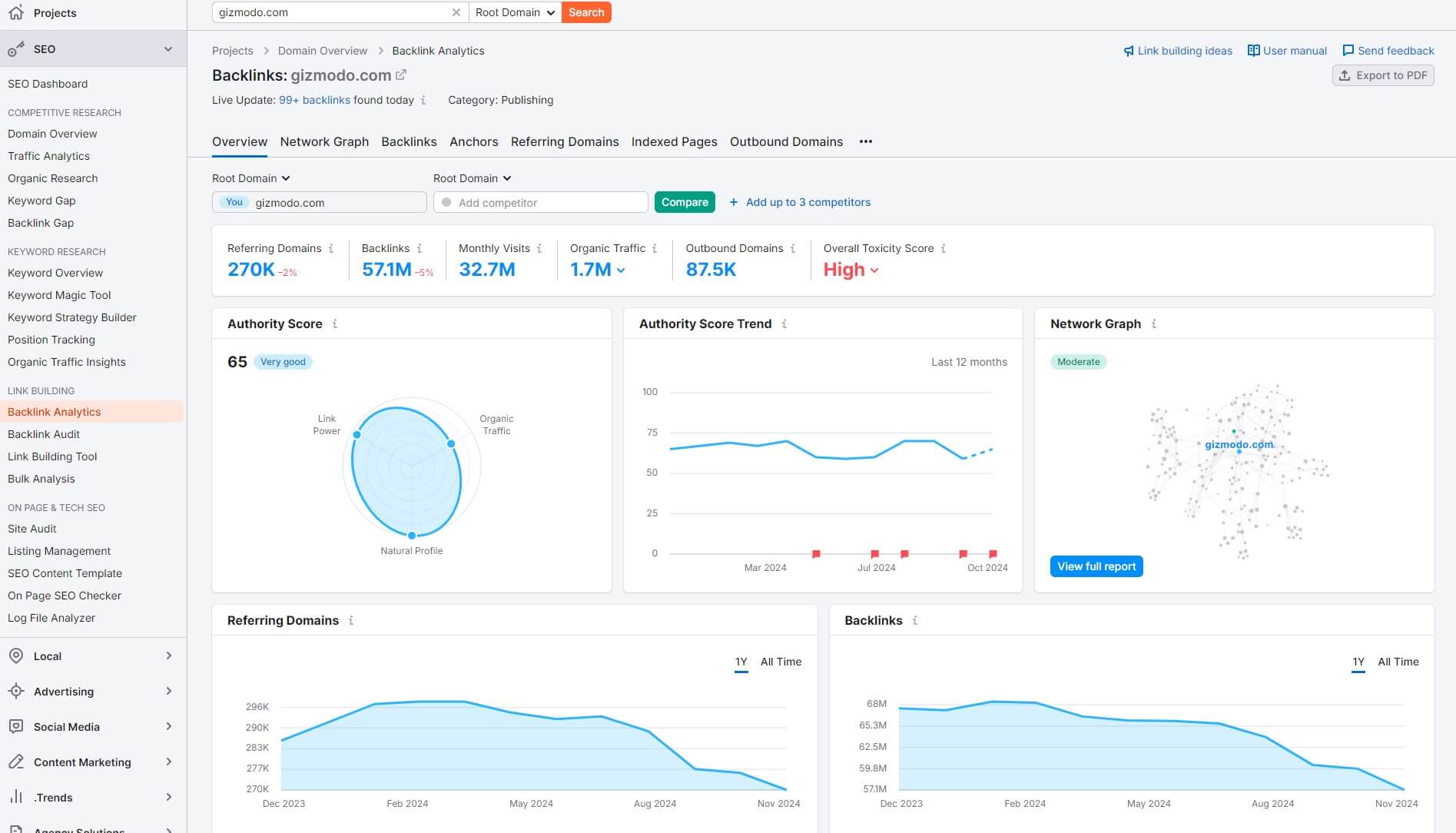 © Semrush
© Semrush
These bits of data let you gauge your competitor’s strength. If it has more links coming from authoritative websites, it’s a strong one. A good backlink profile shouldn’t have too many toxic backlinks. This SEO competitor analysis lets you discover the top pages.
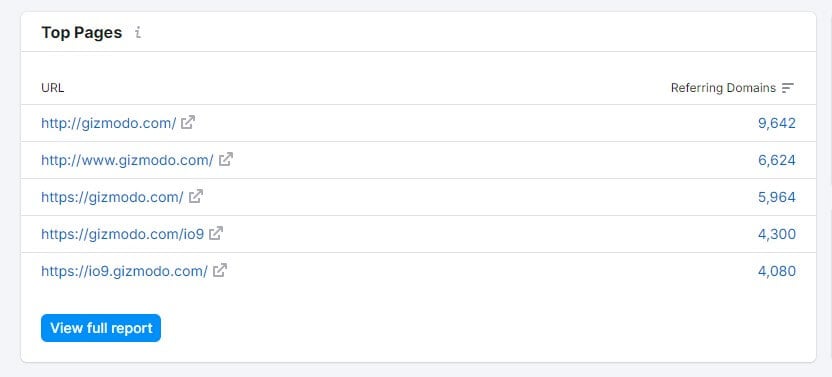 © Semrush
© Semrush
These pages have received the most backlinks, so it’s smart to click them and see what they have to offer. We’ll discuss what you should look for in that case a bit later.
Backlink Auditing
For now, let’s mention backlink auditing. Now, not many SEO tools have this one. However, Semrush does and it’s called simply Backlink Audit. Select this tool, enter the domain address of your rival, and find out more about the backlink profile quality. We mentioned a few tips.
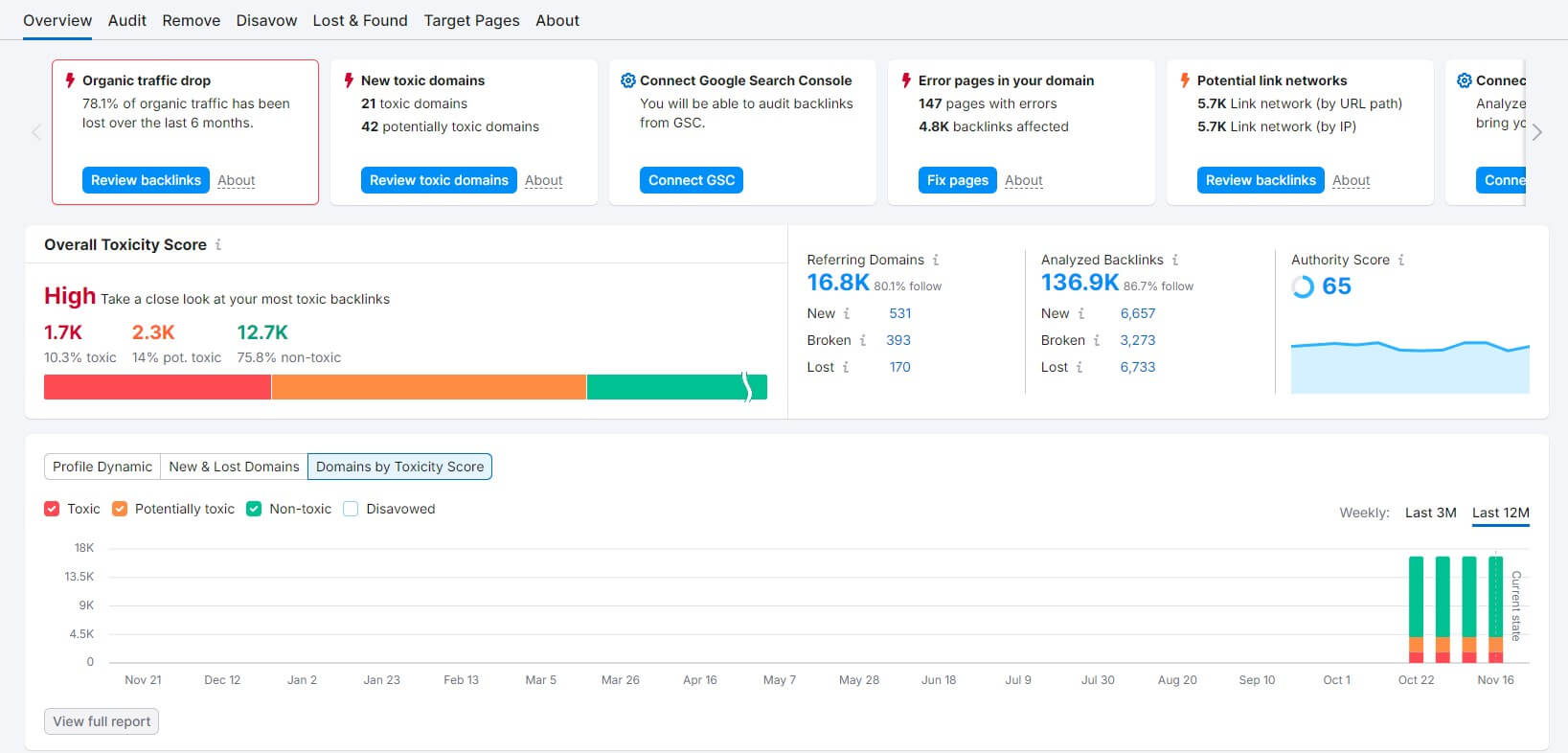 © Semrush
© Semrush
One is backlink toxicity; the higher score indicates a “smarter” backlink strategy. Another thing you can look for is anchors. You’ll see the top 100 anchors used to link to your competitor. We also recommend analyzing so-called Follow and NoFollow links.
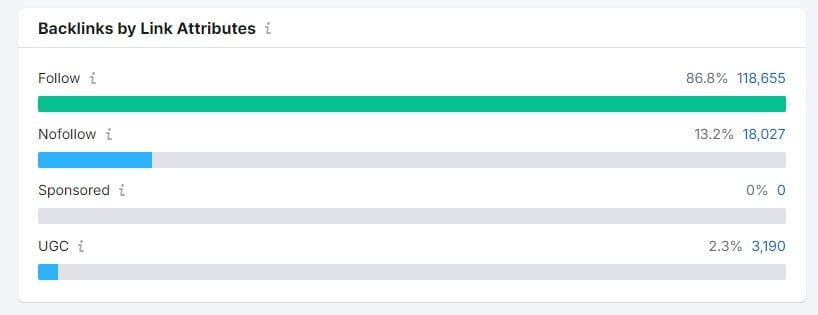 © Semrush
© Semrush
If the competitor has plenty of Follow links, it’s an indicator of a stronger backlink profile. These links add to your SEO tremendously because they give credit to your domain. If a website links to you and uses the NoFollow attribute, no credit has been given.
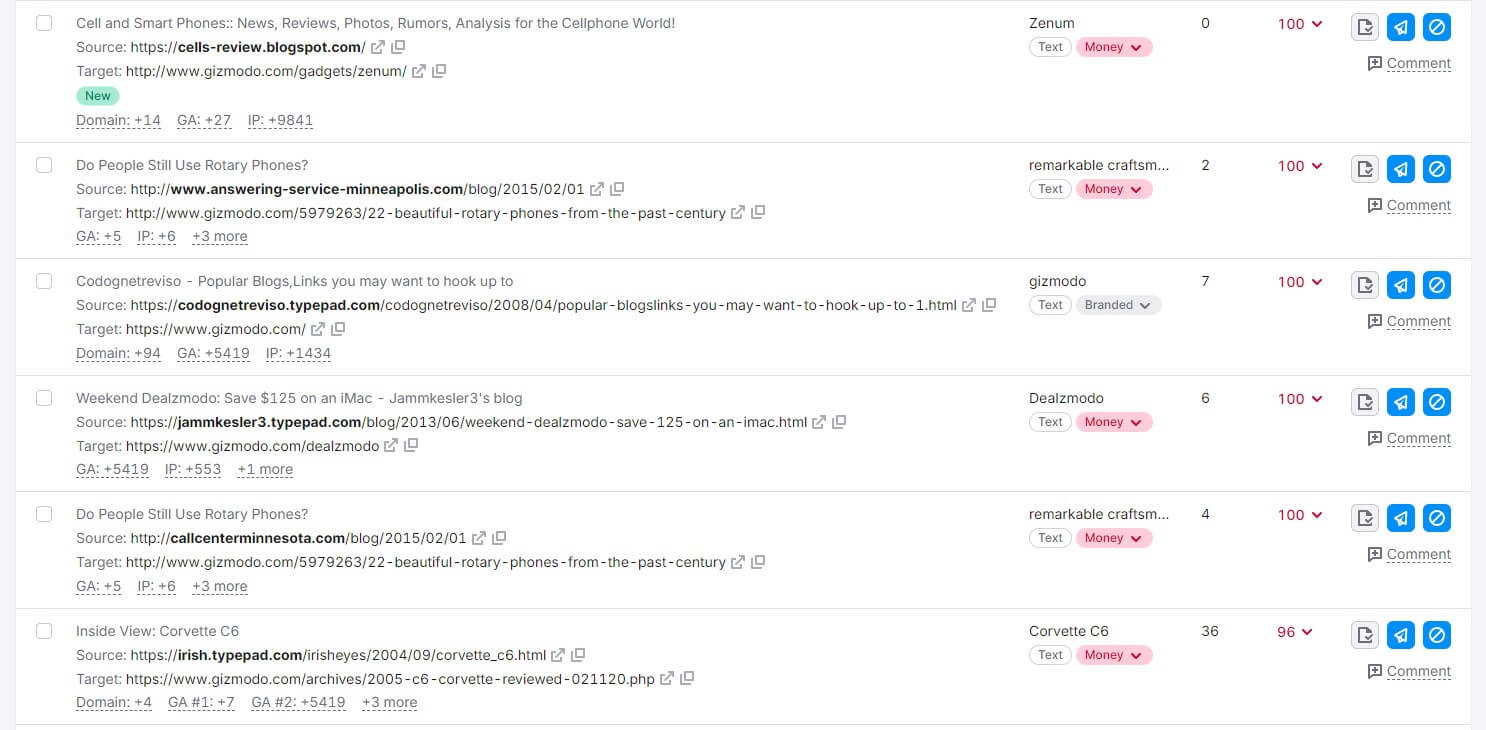 © Semrush
© Semrush
Discovering Follow links can be done via the Audit tab in Semrush’s Backlink Analytics. You’ll see their anchors and toxicity scores for further analysis. This information can be used to craft a new backlink strategy and see which domains usually link to your rivals.
Later on, you can use Semrush’s Link-Building tool to get in touch with these domains directly and request a backlink or guest post. You’ll find more about the best backlink-building software here if you want to improve this aspect.
Discovering Backlink Gaps
Remember the keyword gaps from before? Well, backlink gaps are also part of a proper SEO competitor analysis. You can discover them using Semrush’s Backlink Gap tool. Again, provide your domain address and add a few competitors. Press Find Prospects.
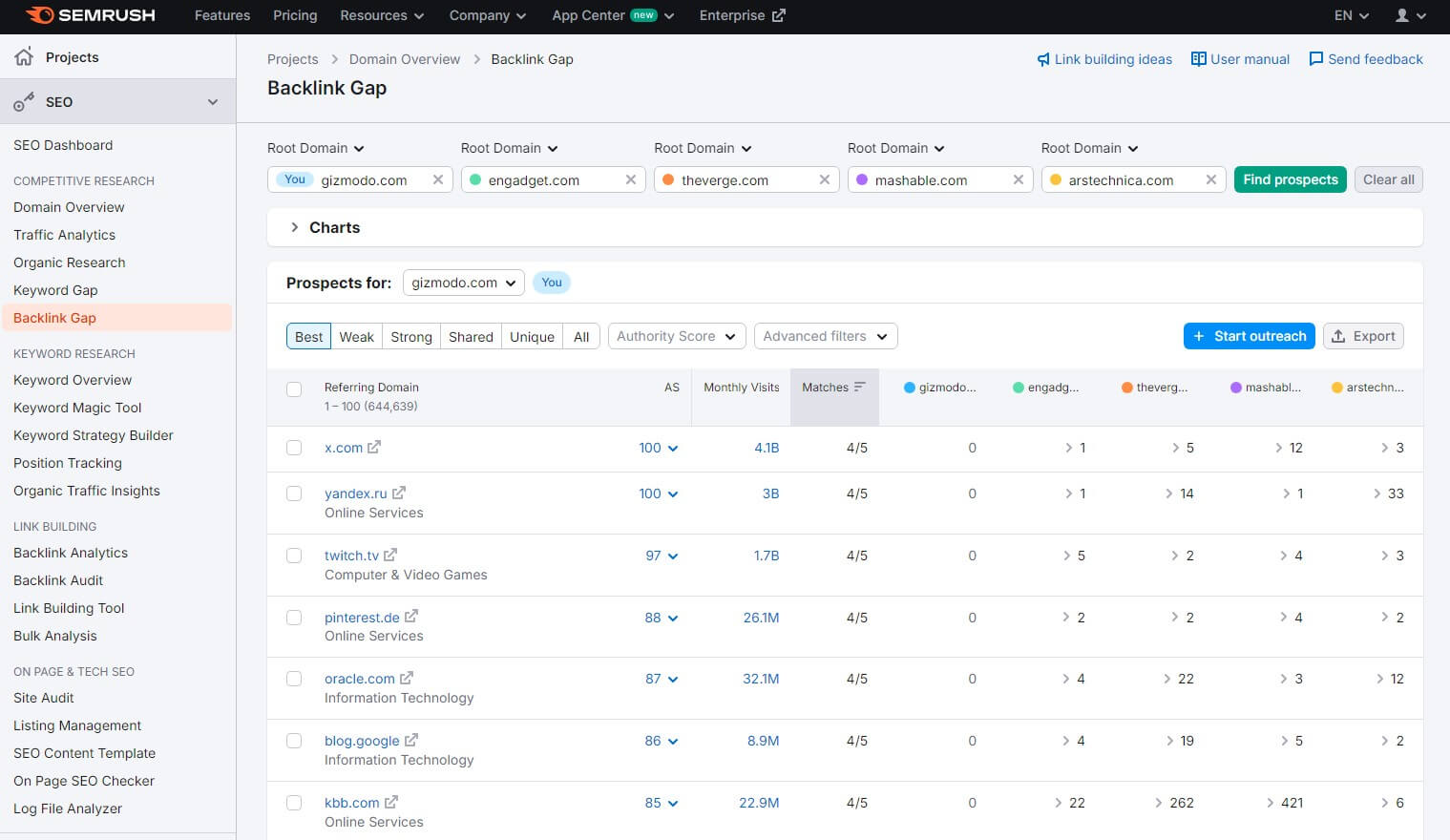 © Semrush
© Semrush
What will you find out? You’ll find the domains that link to your rivals but not your website. As you can see, the Best column should be your primary goal because it highlights the most authoritative backlinks of your rivals. These should be your main focus in the future.
Fill the Backlink Gaps Using Semrush
Search for Page Weaknesses (and Strengths)
An SEO analysis of your competitors boils down to finding their weaknesses. However, our experience has shown you also must know their strengths. This way, you can replicate and improve upon something good while avoiding your rivals’ pitfalls and mistakes.
In this part of our SEO competitor analysis guide, we’ll focus on page-related things, such as:
- Content quality and length
- Title tags and meta descriptions
- Featured snippets
We’ll explain everything in detail.
Content Quality and Length
You can’t rank higher with an empty site. Content is required but not just any. You need high-quality content that excels in keyword optimization, proper internal linking, and many backlinks. Above all, your content must be written well and easy to digest.
The goal is to analyze your competitor’s content on the most visited pages. You can do that with Organic Research from Semrush. Just scroll down and find the Top Pages section. Open them up and analyze every corner. Every letter. Every sentence. Look closely.
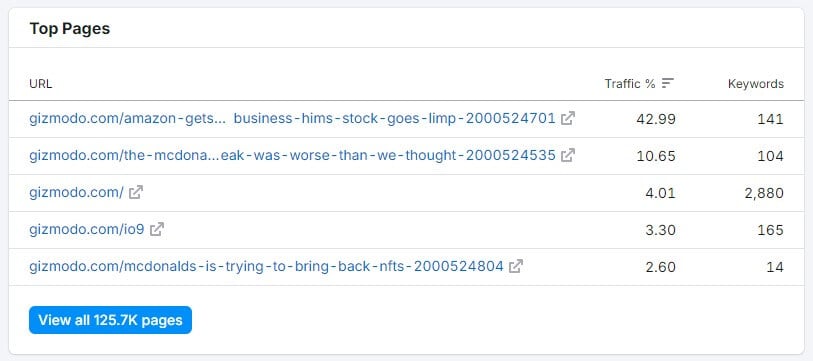 © Semrush
© Semrush
Are these pages perhaps short? Or is it long-form content? In our guide about driving more traffic to the website, we explained that long-form content usually ranks better.
Next, you want to examine the writing quality and see what kind of sentences and layouts are used.
You also want to inspect images, infographics, and types of pages (reviews, blog posts, …). If the page is doing well, and it surely is because it’s the top page of your rival, you can use it as an inspiration to do something similar but better and more witty.
Semrush’s Content Marketing can also help. You have the SEO Writing Assistant that can improve your writing quality and keyword optimization. The SEO Content Template also brings in some LSI keywords and advised backlinks that you can capitalize on.
Title Tags and Meta Descriptions
Look at your competitor’s title tags. These are the titles you see in search engine results. They tell Google what the page is about, making it rank the page accordingly. In our book, having a proper, SEO-friendly title goes a long way in boosting your ranking.
We want you to glance at your rival’s top pages, as explained a minute ago. Analyze their title tags and cherry-pick their glaring strengths (and weaknesses). “Strong” title tags will have the main keyword there and some attention-grabbing words like “free“, “in 1 minute“, “best guide“, “experts’ opinion“, etc.
 © Google.com
© Google.com
Each title tag is accompanied by a meta description; think of it as a page summary. They aren’t crucial for ranking but are known to boost CTR (click-through rates). Analyze them and see what your competitors do. Usually, the keyword should be there 1-2 times.
Don’t neglect this aspect because it’s still important, especially for larger pages or pillar posts. Inspect both and see what works for your competitors. If it works for them, it’ll work for you.
Featured Snippets
Now we’re bringing in the big guns; SERP features. Appearing in a featured snippet is almost a surefire way of instantly boosting your ranking and achieving more visitors. You want to see WHY and HOW your competitors have made it to the featured snippet.
This can be done via Organic Research in Semrush. As always, provide the domain but this time, go to the Positions tab. In the filter column, select SERP Features, press Domain Ranks, and then choose Featured Snippet.
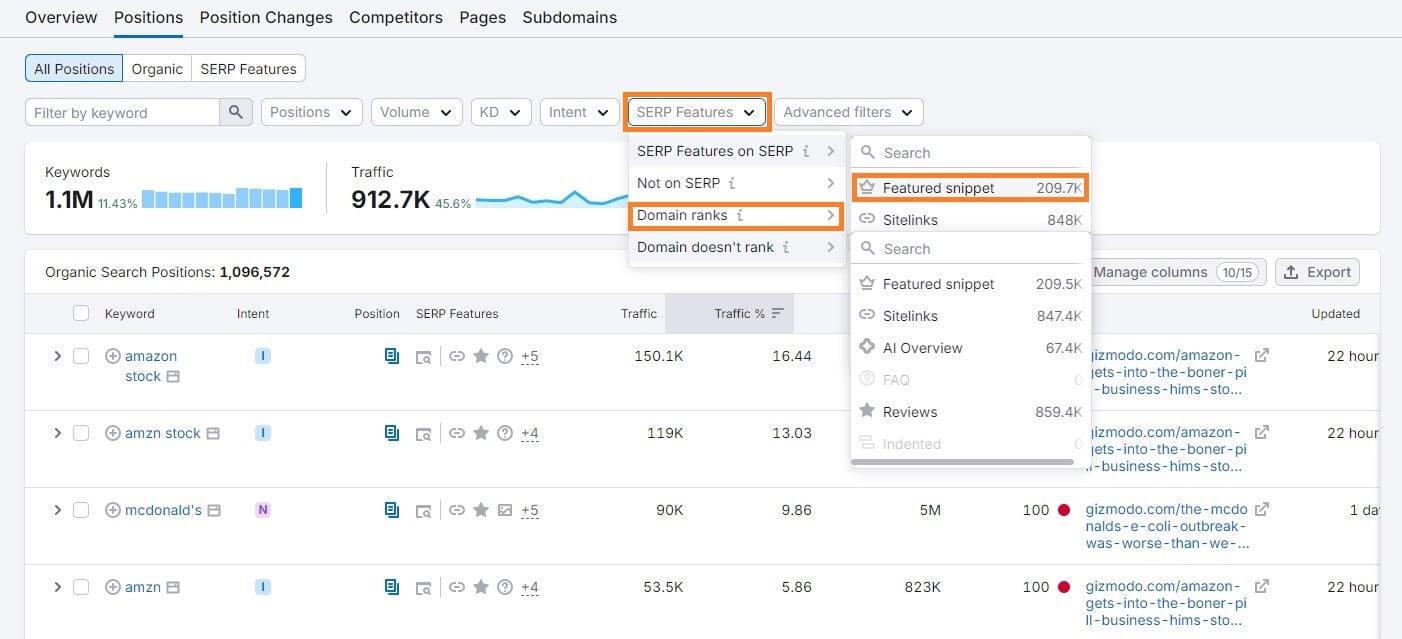 © Semrush
© Semrush
You’ll now locate the keywords that put the competitor’s page in the featured snippet.
What can you do with this SEO competitor analysis? You can use the same keyword and try to better optimize the page.
 © Google.com
© Google.com
A featured snippet is a short explanation of a specific term. You must be better at describing or explaining something to overtake the rival and appear in the featured snippet.
We can’t tell you how to do that; you’ll have to be witty enough.
Don’t Forget Technical SEO
While your keyword optimization might be on point, technical aspects of your site can be lacking severely, dragging you down as a result. You can discover these issues by auditing your website but guess what – you can also audit your competitor’s websites!
When it comes to technical SEO, the goal is to improve the website performance, speed, user experience, and crawlability. We recommend auditing your website first and then moving on to the competitor. You can then compare the two and see their strengths and weaknesses.
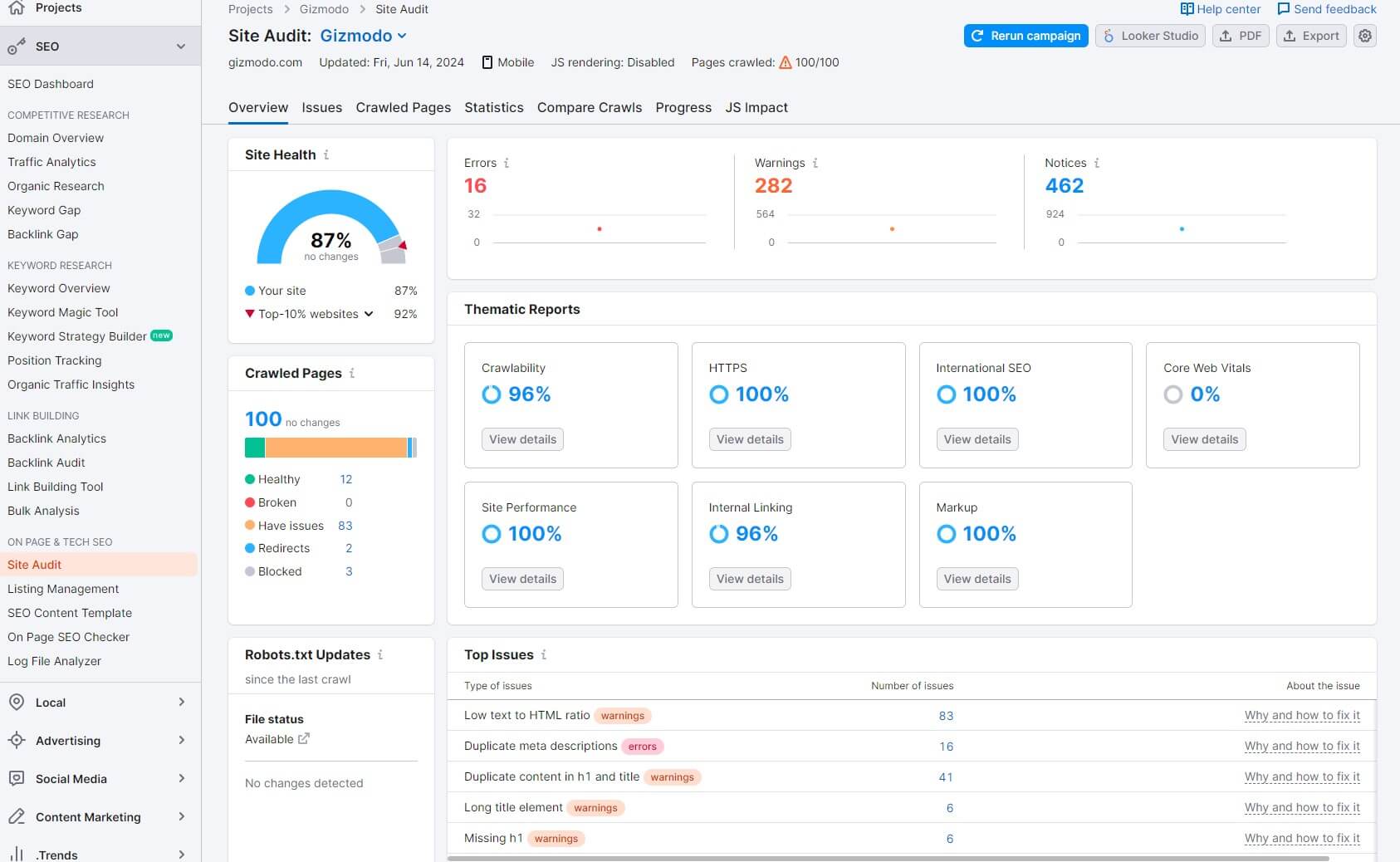 © Semrush
© Semrush
We usually focus on our domain. That’s enough, especially when using Semrush’s Site Audit tool which can instantly discover issues, warnings, and errors. It’ll display their root cause and explain how to fix them. Critical issues, also called Errors, are highlighted in red.
Work on Your Site Weaknesses With Semrush
These can be serious problems, such as broken internal links, 4xx errors, and broken images. SE Ranking and Semrush can also audit individual pages, which can be used on your competitor. Analyze the page and then do that for the matching page on your website.
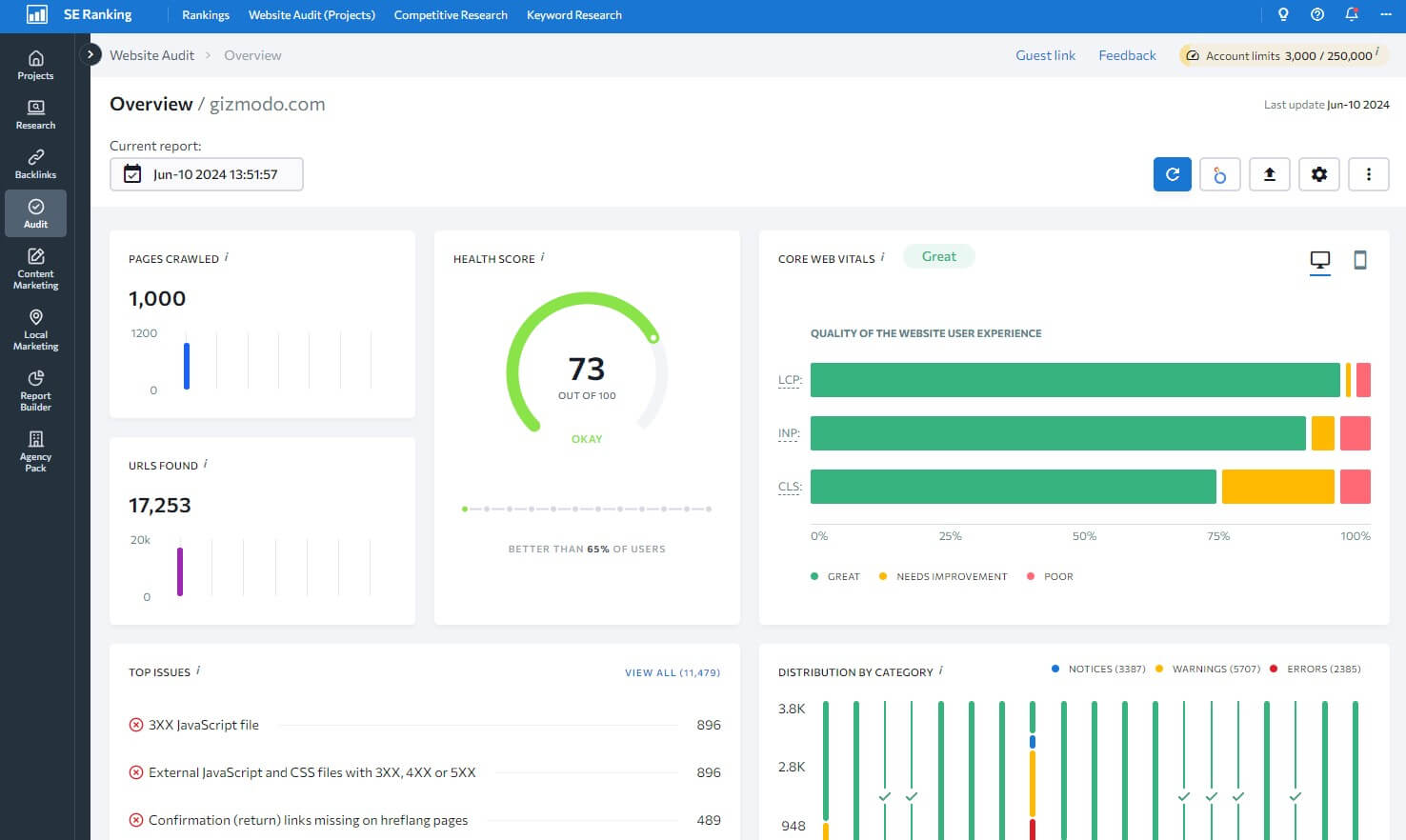 © SE Ranking
© SE Ranking
You’ll see if the competitor’s page is superior and in which aspects. You can use its weaknesses and capitalize on them or look up to its strengths. Ensure you perform an SEO audit at least once a month to keep everything running smoothly.
Discover Domain Errors With SE Ranking
How to Do an SEO Competitor Analysis Automatically?
With many layers of this analysis, it’s hard to always resort to manual labor. Luckily, most SEO tools have reports that can be scheduled in advance, with the analyses you choose to perform. SE Ranking and Semrush are our favorites in this regard because they’re so simple.
Semrush lets you craft a monthly report under Management, where you’ll find My Reports. If you click this option, you’ll an empty page where you can drag and drop the things you need. For example, the first page can contain your organic competitors from before.
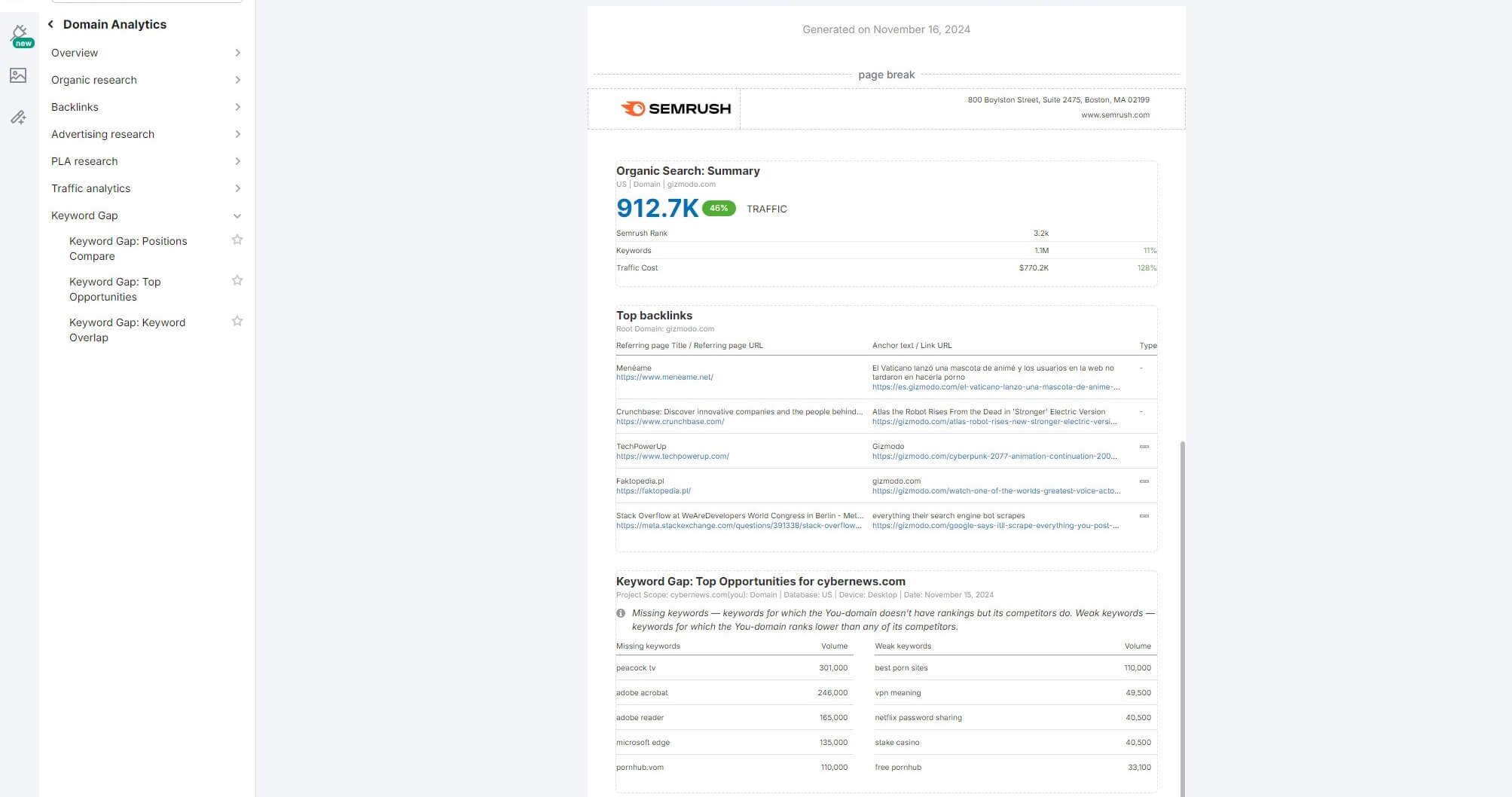 © Semrush
© Semrush
You’ll select the Organic Research tool, drag it to the page, and set the parameters accordingly. Next, on the same or another page, you can include the Keyword Gap report which will highlight the missing keywords you can aim for, and so forth.
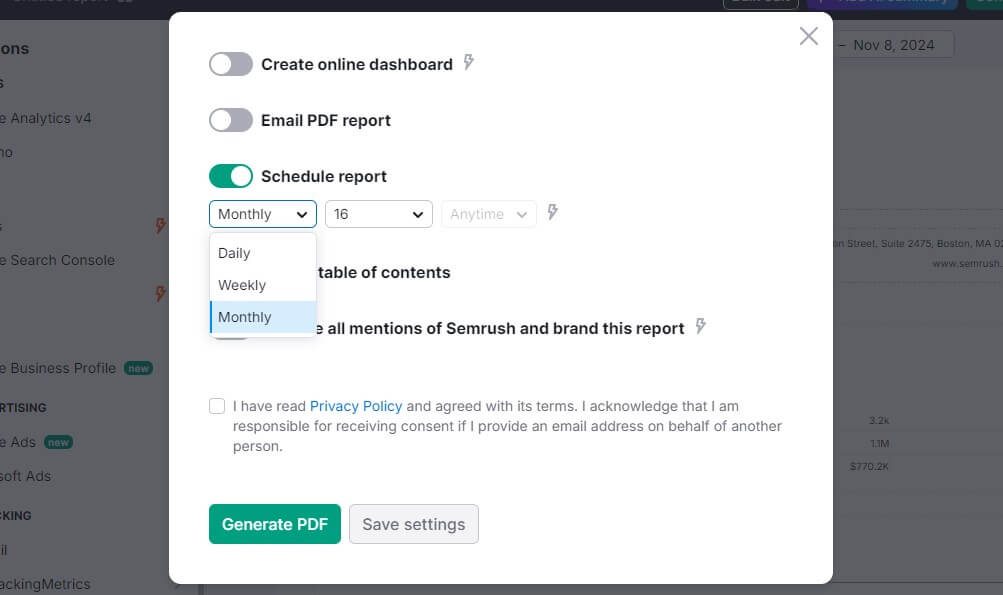 © Semrush
© Semrush
Semrush and SE Ranking allow you to schedule these reports. We prefer having a monthly report, for example. Each month, on the same day, both tools will have your report ready, containing all the information you wanted for an SEO competitive analysis.
This will let you assess the situation and take note of changes; for the better or for worse.
While reviewing SE Ranking, we enjoyed this feature and used it to avoid laborious and repetitive tasks. A simple monthly report can do this for you if you configure it right.
Schedule SEO Reports With Semrush
Summary
You should now know how to do an SEO competitive analysis and set yourself up for a path of success.
Our many steps are enough to keep you informed of your competition’s trends, SEO strategies, keyword optimization, and backlink tactics.
Knowing all of this is the first step to making your website SEO perfect. Once you discover your rivals’ weaknesses and use them to your advantage, you’ll be able to get atop. But don’t forget that your competitors do the same! That’s why our SEO tools are necessary.
Using two capable options such as Semrush and SE Ranking will help plentifully. They’ll improve and maintain your SEO through insightful data, simultaneously providing monthly reports to steer you in the right direction.
FAQ
Looking for more info on competitor SEO analysis? We’ve got you covered.
Which SEO tools offer competitive analysis features?
Feature-rich tools will give you the best result. Semrush is our experts’ choice and we boosted dozens of our websites using it. SE Ranking is another phenomenal option with pretty much the same suite of tools at a way lower price.
Should you avoid some? Yes!
Tools that often specialize in a single SEO aspect are underwhelming. For example, Mangools lacks Keyword/Backlink Gap tools, making it instantly inferior to Semrush and SE Ranking. SEO competitor analysis is a broad “discipline”, so don’t limit yourself.
How often should I analyze my competition?
It depends on multiple factors but the rule of thumb is monthly. We’d take into account algorithm updates, the severity of your competition, and the niche size. If you encounter an algorithm update, it’s smart to perform SEO competitor research just in case.
Some updates can make your site flourish or worse; plummet. You want to counter this by immediately analyzing the competition and acting quickly to prevent further degradation. Generally, performing this analysis once or twice a month should suffice.
Can I perform an SEO competitor analysis for free?
Yes. Free SEO tools are also viable but rarely great. You’ll get a few tidbits from them but don’t expect in-depth analyses, scheduled reports, and other premium stuff. They’re great to get a glimpse of how an SEO competitor analysis works. Once you’re done, move on.
Subscribe to a premium service like Semrush or SE Ranking; it’ll pay off pretty quickly. By the way, both of them offer a free trial. You can find more information in our article that explains how to take advantage of Semrush’s 14-day free trial.




